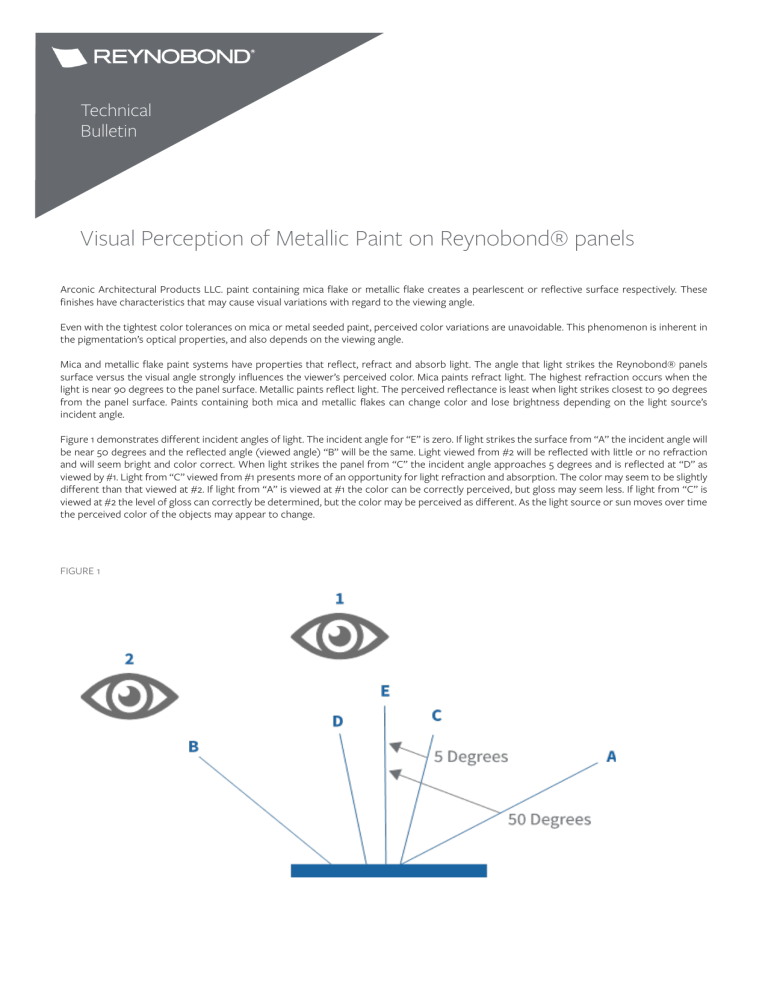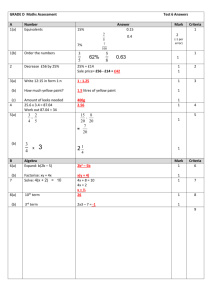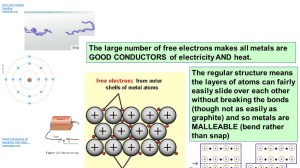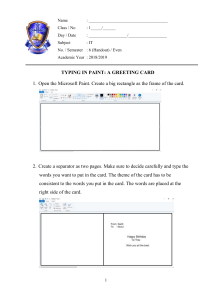
Technical Bulletin Visual Perception of Metallic Paint on Reynobond® panels Arconic Architectural Products LLC. paint containing mica flake or metallic flake creates a pearlescent or reflective surface respectively. These finishes have characteristics that may cause visual variations with regard to the viewing angle. Even with the tightest color tolerances on mica or metal seeded paint, perceived color variations are unavoidable. This phenomenon is inherent in the pigmentation’s optical properties, and also depends on the viewing angle. Mica and metallic flake paint systems have properties that reflect, refract and absorb light. The angle that light strikes the Reynobond® panels surface versus the visual angle strongly influences the viewer’s perceived color. Mica paints refract light. The highest refraction occurs when the light is near 90 degrees to the panel surface. Metallic paints reflect light. The perceived reflectance is least when light strikes closest to 90 degrees from the panel surface. Paints containing both mica and metallic flakes can change color and lose brightness depending on the light source’s incident angle. Figure 1 demonstrates different incident angles of light. The incident angle for “E” is zero. If light strikes the surface from “A” the incident angle will be near 50 degrees and the reflected angle (viewed angle) “B” will be the same. Light viewed from #2 will be reflected with little or no refraction and will seem bright and color correct. When light strikes the panel from “C” the incident angle approaches 5 degrees and is reflected at “D” as viewed by #1. Light from “C” viewed from #1 presents more of an opportunity for light refraction and absorption. The color may seem to be slightly different than that viewed at #2. If light from “A” is viewed at #1 the color can be correctly perceived, but gloss may seem less. If light from “C” is viewed at #2 the level of gloss can correctly be determined, but the color may be perceived as different. As the light source or sun moves over time the perceived color of the objects may appear to change. FIGURE 1 Using panels manufactured from one coil of material offers the least color variability for painted products. Even within one coil, however, the finished panels may appear different when mounted on a building. Light striking the panels at or near 90 degrees to the panel surface can have a different look than light striking the panels at a 45-degree angle. A spectrophotometer is a device that measures color and gives results in a format known as L*a*b*. Hunter L*a*b* and CIE (Commission Internationale d’Eclairage) L*a*b* (CIELAB) are the two common scales. CIELAB is based on cubed roots, while Hunter L*a*b* is based on square roots. Hunter L*a*b* and CIELAB are both color scales based on the Opponent-Colors Theory, which assumes that the receptors in the human eye perceive color as the following pairs of opposites: Light-Dark (L* component) Magenta-Green (a* component) Yellow-Blue (b* component) Even the most sophisticated color measuring equipment cannot replace the human eye as the final judge for color approval. Paints containing mica and metal flake pigments tend to disrupt the ability of a spectrophotometer or colorimeter to distinguish slight color variations. These metallic flake finishes should be approved visually for color acceptance. Tolerances for metallic flake paint of ± 0.2 Delta-E may be possible. Additional ingredient and process variation increase the working tolerance to ± 0.5 Delta-E. The trained human eye can perceive less than ± 0.2 Delta-E color variations between two vertical panels. Causes of possible tolerance in color variations are shown in Figure 2. These tolerances are cumulative and can lead to perceived color differences. The arrow that links the processes demonstrates graphically the increased buildup in paint system tolerance. When viewing opaque versus metallic painted panels having the same Delta-E values, the perceived color variation in the metallic paint may not be as evident as the opaque paint. The human eye can detect overall color differences of opaque or solid colors greater than 0.5 Delta-E. FIGURE 2 Paint supplied to the roll coater with a product tolerance of ± 0.2 Delta Lab. Coiled metal supplied to Reynobond® Plant with a product tolerance of ± 0.5 Delta Lab. Reynobond® Panels are delivered to the fabricator with a tolerance of ± 0.5 Delta Lab (no change after roll coater). Reynobond® panels installed on building with tolerance of ± 0.5 Delta Lab (no change after roll coater). FIGURE 3 CAUSES OF EXPANDED TOLERANCE LEVELS CAUSES OF EXPANDED TOLERANCE LEVELS CAUSES OF EXPANDED TOLERANCE LEVELS CAUSES OF EXPANDED TOLERANCE LEVELS • Ingredients • Mixing method • Metallic flake size and shape • Multiple batches for one order • Process variation • Paint type • Paint viscosity • Size / Shape of mica / metallic • Multiple coils • Multiple paint containers • Inconsistent stirring of paint • Process variation • Metal from multiple coils • Multiple run orders • Production variation • Mounting method and accuracy • Multi-run order for panels • Variability of local workforce Delta-E is not always reliable by itself, especially with mica and metallic paints. Due to the method of calculating Delta-E, shifts in one of the color ranges can cause a perceived difference in the color with no change in Delta-E. Color samples should be visually inspected for approval. Samples should be viewed in light conditions that will be present throughout the day to determine if the perceived color, as viewed by the human eye, is as expected. A visual mockup of mica or metallic painted panels is the architect or designer’s best tool. Specific information regarding mica and/or metallic paint systems should be obtained directly from the paint manufacturer. Laws and building and safety codes governing the design and use of AAP’s products, and specifically aluminum composite materials, vary widely. It is the responsibility of the owner, the architect, the general contractor, the installer and the fabricator/transformer, consistent with their roles, to determine the appropriate materials for a project in strict conformity to all applicable national, regional and local building codes and regulations. ©2018 Arconic Architectural Products LLC. Reynobond® and Reynolux® are a registered trademark of Arconic Inc. ARCONIC ARCHITECTURAL PRODUCTS LLC 50 Industrial Boulevard Eastman, GA 31023-4129 Tel. 800 841 7774 www.reynobond.com






![[Agency] recognizes the hazards of lead](http://s3.studylib.net/store/data/007301017_1-adfa0391c2b089b3fd379ee34c4ce940-300x300.png)
